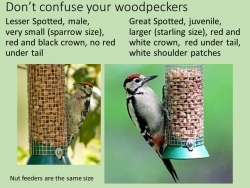Thanks to all LesserSpotNet volunteers who have been searching for LSW breeding territories and nests as part of our project.
We are now (late April) coming to the end of the peak period of detectability when birds can be found by their calls and drumming. Even during this period, the birds are by no means easy. As our volunteers will know well.
The good news – observers in Devon, the New Forest, Norfolk and Sussex have found Lesser Spots excavating nesting cavities and some look ready for the female to lay eggs.
The females lay one egg each morning and only start incubating once the clutch is complete, usually 5 or 6 eggs. Incubation takes only 11 days and the young take another 20 days or so to be ready to fledge. Lesser Spots typically lay eggs from 20 April up until the middle of May. However the weather has an effect, the warm weather encourages the caterpillars on Oak tree to grow but the dry spell may be slowing things down.
If you have already been fortunate enough to find a nest cavity or excavating bird please keep following the nesting attempt and contact Ken Smith at
Once the birds are settled into incubation and all the leaves emerge finding nests is much more challenging but from mid-May alarming adults or calling young may lead you to the nest. See more tips on finding and observing nests here. Lesser Spot young in the nest are noisy but far less so than Great Spotted Woodpeckers. You probably need to be within about 20m of a Lesser Spot nest to hear the young calling.
This spring Woodpecker Network has collaborated with Rob Clements in organising LSW survey for Hampshire Ornithological Society, http://hantslesserspots.birdsurvey.org.uk/. It is based on 1km squares which is a manageable survey area and a good match for the home range of a lesser spot. In the New Forest, HOS volunteers have found good numbers of birds with well over 100 occupied 1km squares. The results are not yet all in but it looks as though few birds have been found elsewhere in Hampshire. We will be writing up the survey for the Hampshire Bird Report in due course.
One of the most striking discoveries is just how fickle these birds can be. A visit to a 1km square one day can produce no contacts but a few days later there can be lesser spots calling and drumming everywhere. There seems to be no substitute for multiple visits to be sure that birds are present. In the HOS survey method we asked observers to make three visits to each square but we now think this is the absolute minimum and more is better.
It has been very pleasing that over the last few months various bird groups have put in a special effort to find lesser spots. In Sherwood the RSPB staff and volunteers have focused on their birds, in Blean Woods in Kent a small team of volunteers have been mapping lesser spots throughout the large woodland complex and in Norfolk, Suffolk and Sussex the local teams have been finding birds and new sites. Last but not least, the Durham Bird Club are making a special effort this year to find their birds There are others also picking up the challenge.
Further news will be posted on this website soon.




